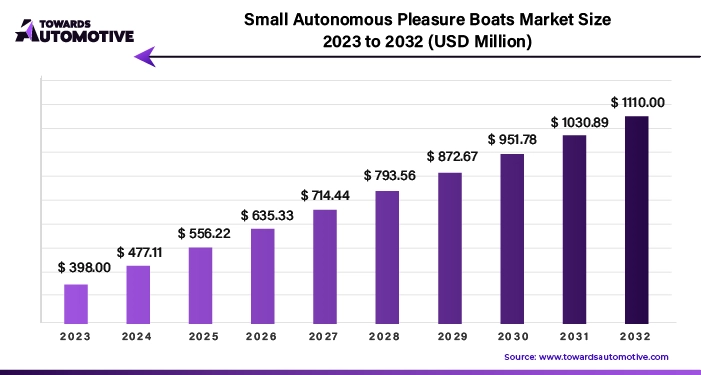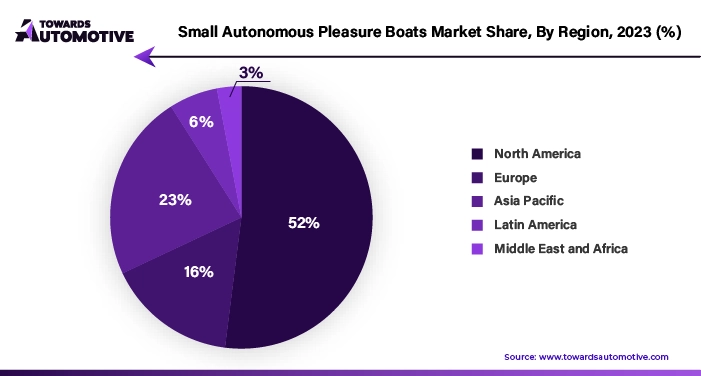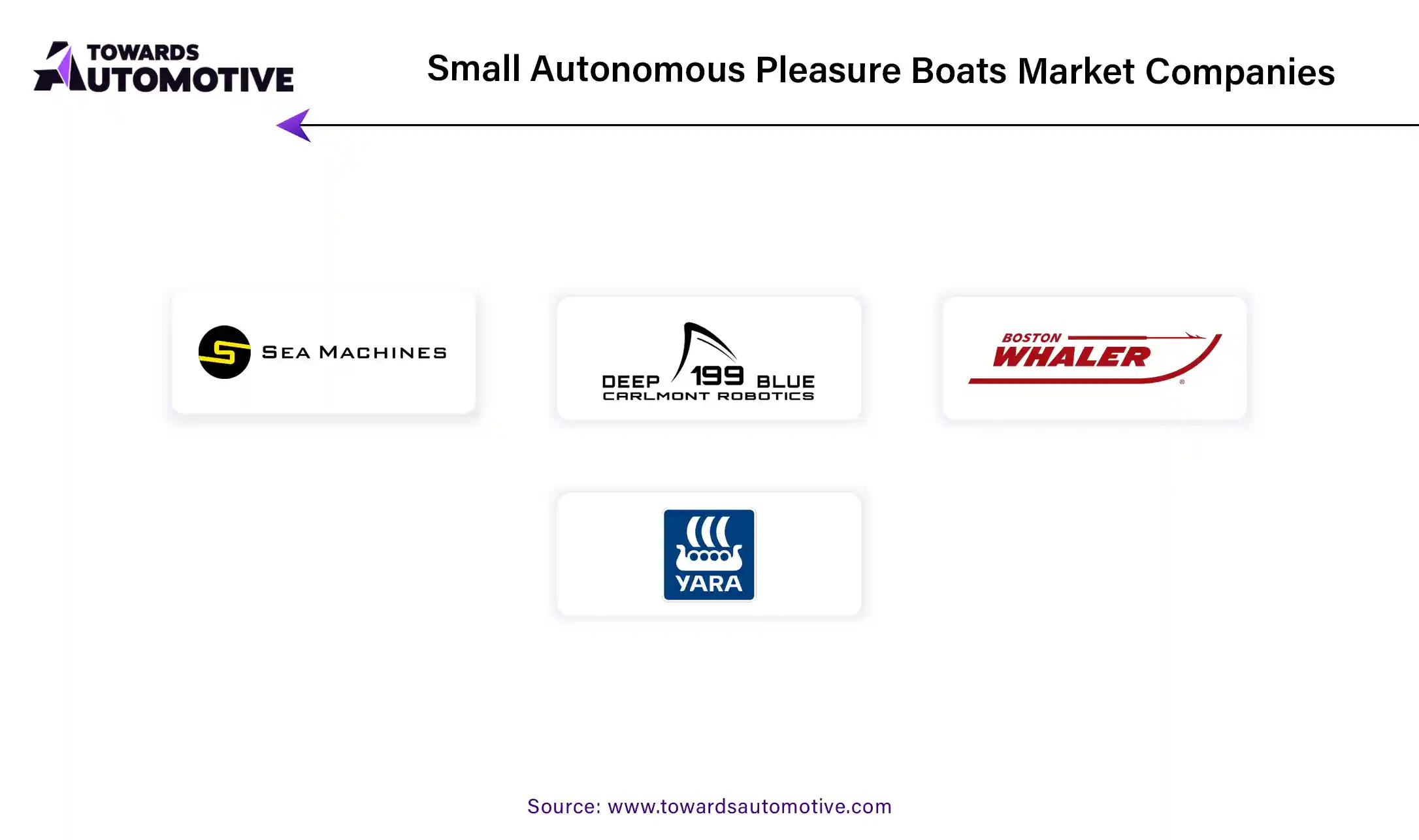April 2025
The small autonomous pleasure boats market is anticipated to grow from USD 480.18 million in 2025 to USD 1,117.50 million by 2034, with a compound annual growth rate (CAGR) of 9.84% during the forecast period from 2025 to 2034.

Unlock Infinite Advantages: Subscribe to Annual Membership
The small submarine market has experienced significant growth, with a value of US$458.6 million in 2022, and is projected to expand at a compound annual growth rate of over 9% from 2023 to 2032. This growth is primarily attributed to technological advancements driving innovation in autonomous driving, sensor technology, and remote control capabilities within the sector.
One notable example of technological innovation is the development of the "New Boat Dock" driving system by Korean HD Hyundai Co.'s subsidiary, Avikus, in September 2023. This system enables recreational boats to navigate autonomously, enhancing safety, flexibility, and usability for boat operators. Such advancements are crucial in making small submarines safer, more efficient, and more user-friendly, thereby fueling market growth.
Furthermore, the sector's focus on sustainable and environmentally friendly transportation is a key driver of its expansion. Both consumers and governments increasingly prioritize environmental considerations, leading to a growing demand for autonomous cruise ships that operate on electricity or other clean fuels. These vessels not only produce fewer emissions but also reduce dependence on fossil fuels, promoting cleaner waterways.
Despite the promising growth prospects, the development and implementation of autonomous applications, sensors, and navigation systems entail significant investment. Moreover, the costs associated with building or retrofitting ships to accommodate these technologies can be substantial. Addressing this challenge will require efforts to reduce production costs through innovation or explore financing options to make autonomous small submarines more accessible to a wider range of customers.
The COVID-19 pandemic has brought about a notable shift in consumer behavior, positively impacting the small submarine market. With concerns over safety and a desire for remote entertainment, there has been a surge in interest in outdoor activities, including boating. Families and individuals, seeking ways to enjoy leisure time while adhering to social distancing guidelines, have turned to boating as a viable option.
This increased interest in boating has also translated into a greater demand for driverless boats or autonomous cruise ships. As people seek safer and more isolated forms of recreation, the convenience and novelty of driverless boats have become increasingly appealing. These autonomous vessels offer passengers the opportunity to enjoy water-based activities without the need for direct human intervention, thereby enhancing both safety and convenience.
Overall, the COVID-19 pandemic has served as a catalyst for the small submarine market, driving up interest in boating and accelerating the adoption of driverless boat technology. This trend is expected to persist as consumers continue to prioritize outdoor activities that offer safety, relaxation, and a sense of freedom amidst ongoing public health concerns.
The pursuit of efficiency and environmentally friendly travel has propelled the adoption of electric propulsion within the small submarine industry. Electrically powered submarines offer several advantages, including reduced noise levels for quieter operation, particularly in sensitive marine environments. Moreover, they are environmentally sustainable, producing zero emissions and minimizing ecological impact on aquatic ecosystems. As safety concerns continue to grow, sailors are increasingly turning to electric and autonomous boats, drawn to their cleanliness and safety features, aligning with the broader trend towards sustainable practices in the recreational sailing industry.
The integration of connectivity and IoT (Internet of Things) technologies has become a significant phenomenon in the small submarine market. IoT devices, sensors, and connected solutions are being leveraged to enhance navigation systems and provide advanced monitoring and control capabilities for submarines. This enables passengers to access real-time information regarding navigation, safety, and onboard systems through mobile applications or dashboard interfaces. For instance, Voyis Imaging Inc.'s "Discovery Vision Systems," introduced in April 2023, exemplifies this trend by offering high-resolution video and real-time 3D visualization capabilities to enhance operational efficiency and safety during underwater tasks such as navigation, inspection, and surveillance.
On the basis of propulsion power, the small submarine market is segmented into diesel engines, electric motors, and hybrids. In 2022, the diesel engine segment is expected to maintain its dominance. Diesel engines are renowned for their fuel efficiency and high torque, making them well-suited for large submarines that require extended range capabilities. Additionally, advancements in diesel engine technology have led to improved efficiency and safety, particularly in comparison to gasoline-powered alternatives. The reliability and durability of diesel engines have further contributed to their popularity in the small submarine market, especially among owners of vessels intended for long-distance sailing and exploration.
Regarding the degree of autonomy, the small submarine market is divided into two main segments: manned and unmanned. The manned segment, also known as the cruise segment, is projected to represent approximately 55% of the market by 2022. This segment is experiencing significant growth, driven by the rising popularity of recreational boating activities. Luxury yachts within this segment are specifically designed to cater to the leisure and comfort needs of passengers, featuring amenities such as power steering, enhanced stability, and onboard equipment aimed at enhancing the overall sailing experience. With a focus on comfort and relaxation, these cruise submarines appeal to individuals and families seeking enjoyable and immersive water-based adventures.
North America emerges as the leading region with vast network of rivers, lakes, and coastlines across the continent positions North America as a prime destination for recreational boating activities. Consumers in the region are increasingly embracing autonomous boats, which are frequently equipped with electric or hybrid propulsion systems, aligning with escalating environmental awareness and travel-related concerns. Moreover, the implementation of robust regulations and government incentives aimed at promoting environmentally sustainable transportation solutions serves to bolster the adoption of cruise ships in North America.


Major players operating in the Small Autonomous Pleasure Boats industry
Sea Machines Robotics and Deep Blue Robotics have emerged as industry leaders, leveraging their technological prowess and extensive business expertise. Sea Machines Robotics specializes in autonomous control and navigation applications, pioneering solutions aimed at enhancing the safety and precision of unmanned vessels. Meanwhile, Deep Blue Robotics has earned acclaim for its cutting-edge propulsion systems, encompassing electric and hybrid options. This positions Deep Blue Robotics as a pivotal player within the environmentally conscious and efficiency-driven Sail Freedom industry, perfectly aligning with prevailing industry trends and evolving customer preferences.
By Propulsion
By Application
By level of Autonomy
By Geography
April 2025
April 2025
April 2025
April 2025
We offer automotive expertise for market projections and customizable research, adaptable to diverse strategic approaches.
Contact Us